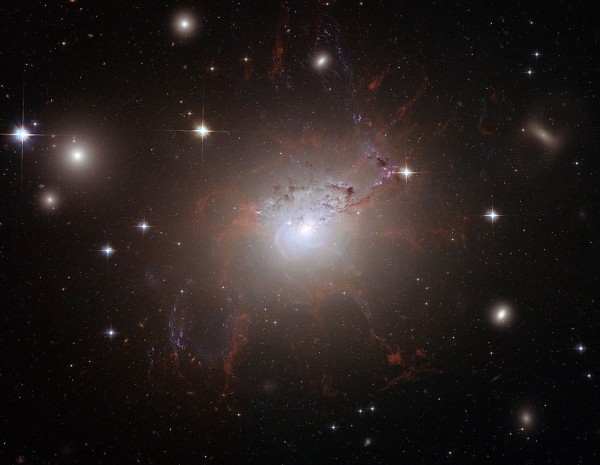Scientists Say 'Red Geysers' Make Dormant Galaxies
| K. Salugsugan | | May 27, 2016 10:16 AM EDT |
(Photo : NASA/ESA via Getty Images) This handout image of the giant, active galaxy NGC 1275, obtained August 21, 2008 was taken using the NASA/ESA Hubble Space Telescope's Advanced Camera for Surveys in July and August 2006.
Galaxies have turned into deserts without young stars billions of years ago due to galactic warming. The phenomenon has puzzled astronomers to identify the process that makes the gas in these galaxies too energetic and hot to make stars.
Sloan Digital Sky Survey recently announced the discovery of red geysers, a new galaxy class that are able to harbor winds with supermassive black holes. According to them, these are what make dormant galaxies. Lead author Edmund Cheung said, "We knew that there had to be a way to prevent star formation in these galaxies, and now we have a good idea of what it is."
Like Us on Facebook
Cheung, an astronomer from University of Tokyo, was working with astronomers who are studying hundreds of galaxies. In the course of their study, they caught a black hole swallowing the cold gas in the host galaxy.
Giant black holes' cosmic seeds from the early universe have been discovered by astronomers through NASA's Great Observatories in their search for the best piece of evidence. The findings of this research will be published in the new Monthly Notices issue of the Royal Astronomical Society.
The possible giant black hole seeds were identified the combined information gathered from NASA's Hubble Space Telescope, Chandra X-ray Observatory and Spitzer Space Telescope. The research team, which was led by Fabio Pacucci of Scuola Normale Superiore in Italy, revealed that this newly-found discovery may offer an explanation about how giant black holes came to exist. He added that this proves that giant black hole seeds could form straight from the breakdown of a massive gas cloud that skips any intermediate steps.
A giant black hole is believed to lie in the center of almost all massive galaxies, which includes the Milky Way. Scientists have discovered that some of these giant black holes with millions to even billions of times the mass of the Sun, were brought into being after a billion years since the universe started through the Big Bang. A theory suggests that black hole seeds were formed by pulling in gas from their domains and by a combination of smaller black holes, Astronomy magazine reported.
However, the new findings suggest that some of the initial black holes were built directly when a cloud of gas broke down, bypassing any other intermediate stages, like the formation and subsequent destruction of a large star. According to co-author Andrea Ferrara of SNS, there are many controversies over which direction these black holes take. She added that their work suggests that the black holes begin as large and grow at the usual rate instead of beginning small and growing at a very quick rate.
The giant black hole's computer models are being used to determine the candidates for the objects from images gathered from Hubble, Chandra and Spitzer. The scientists are currently forming a theoretical framework to interpret the data, as they try to find the first black holes in the universe, according to Hubble Site.
Tagsred geysers, giant black holes, black hole formation, galaxies, dormant galaxies, Vitality, Space mission, Science and Technology, NASA Image, Hubble Space Telescope
©2015 Chinatopix All rights reserved. Do not reproduce without permission
EDITOR'S PICKS
-

Did the Trump administration just announce plans for a trade war with ‘hostile’ China and Russia?
-

US Senate passes Taiwan travel bill slammed by China
-

As Yan Sihong’s family grieves, here are other Chinese students who went missing abroad. Some have never been found
-

Beijing blasts Western critics who ‘smear China’ with the term sharp power
-

China Envoy Seeks to Defuse Tensions With U.S. as a Trade War Brews
-

Singapore's Deputy PM Provides Bitcoin Vote of Confidence Amid China's Blanket Bans
-

China warns investors over risks in overseas virtual currency trading
-

Chinese government most trustworthy: survey
-

Kashima Antlers On Course For Back-To-Back Titles
MOST POPULAR
LATEST NEWS
Zhou Yongkang: China's Former Security Chief Sentenced to Life in Prison

China's former Chief of the Ministry of Public Security, Zhou Yongkang, has been given a life sentence after he was found guilty of abusing his office, bribery and deliberately ... Full Article
TRENDING STORY

China Pork Prices Expected to Stabilize As The Supplies Recover

Elephone P9000 Smartphone is now on Sale on Amazon India

There's a Big Chance Cliffhangers Won't Still Be Resolved When Grey's Anatomy Season 13 Returns

Supreme Court Ruled on Samsung vs Apple Dispute for Patent Infringement

Microsoft Surface Pro 5 Rumors and Release Date: What is the Latest?














